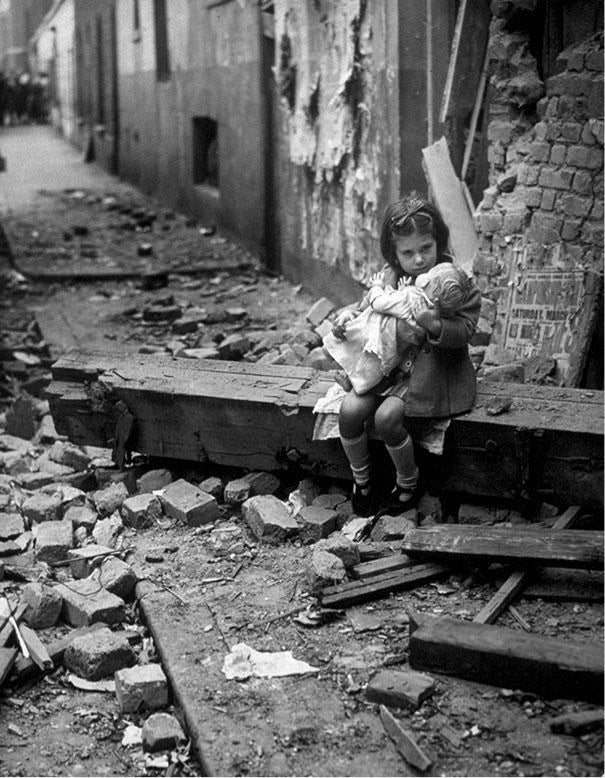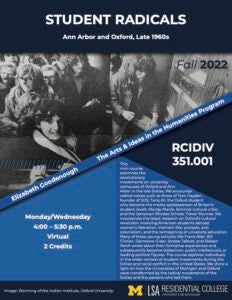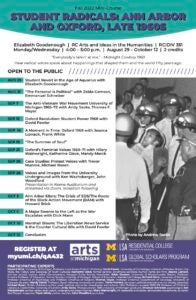RCIDIV 351
Student Radicals: Ann Arbor and Oxford, Late 1960s
Mini-course, open to the public via Zoom and in person.
In this half-semester course, we encounter radical voices such as those of Tom Hayden, founder of SDS; Tariq Ali, the Oxford student who became the media spokesperson of Britain’s student revolt; Mandy Merck, feminist cultural critic; and the Jamaican Rhodes Scholar Trevor Munroe. A new generation of historians examines the revolutionary movements on university campuses in the late Sixties. We incorporate the latest research on Oxford’s cultural revolution involving American students abroad, women’s liberation, Vietnam War protests, anti-colonialism, and the reimagining of university education. Many of these young activists like Frank Aller, Bill Clinton, Germaine Greer, Strobe Talbott, and Robert Reich wrote about their formative experiences and subsequently became statesmen, public intellectuals, or leading political figures. The course explores individuals in the wider context of the American student movement of the Sixties and racial conflict in the United States. We shine a light especially on how the Universities of Michigan and Oxford were transformed by the radical movements of the Sixties and the persons who led them.

RCHUMS 334.003/ENVIRON 304.006
Children Under Fire: Narratives of Sustainability
Children, our greatest natural resource, inherit the consequences of adult decisions about the human environment. Suffering and remembering longest, they lose most in war and natural disaster. Even without armed conflict, homelessness exposes them to sustained fear and danger. How are children represented when scarcity (food and water) and environmental degradation leave them vulnerable? This seminar examines how childhood trauma has been portrayed in picture books, Y/A fiction, fairy tales, and film. Among the questions we investigate are: 1) How have the young been represented globally as killers or consumers, soldiers or refugees, victims or survivors? 2) In what ways do empire, frontier and classic war stories continue to influence narratives? 3) How do gender, national identity, family resilience, guilt and innocence, amnesia and terrorism figure in these stories? Finally we consider whether honest portrayals of misfortune are likely to overwhelm the young. And we look into the impact which crossover writing and expectations of a “happy ending” exert on children’s books.
Reading and Writing Landscapes of Childhood:
Play, Place and Personal Story
(Listed in LSA Course guide: Growing Up Near the Great Lakes)
How do tales of home shape identity? This course explores how the places where we grow up inform our inner landscapes. While some who enroll will have grown up near the Great Lakes, any region possesses the power to influence us eternally. How does place inspire us? What constitutes the sites we call home? How does our sense of belonging and becoming abide within, sustaining or haunting us throughout a lifetime? How do we continue to contain the places we first encountered? In this course we will recall and narrate our own regional memories, our early ideas of nature, many-storied houses, and images of specific playscapes.
Guest speakers, films, experiential learning, memoir writing, and histories of play will enhance our study of children’s literature. Looking at storytelling as a reflection of cultural landscape and mode of perception, we will trace narrative patterns inspired by specific locales using the Great Lakes region as an example. Students will be expected to provide evidence of close reading of texts, to contribute actively to class discussions, to submit environmental autobiography and reaction papers. The class will sometimes meet at the Arboretum (weather permitting) where the environment matches the kind of stories we will explore.
Some of the questions we will probe and discuss are:
• How do writers and illustrators spark young imaginations through stories in which play triumphs?
• What is the meaning of “doing nothing”?
• What is the impact of gender, nationality, and race on identity?
• Why do children gravitate to the margins of worlds designed and dominated by grown ups?
• What impact does nostalgia and apocalyptic vision have on boys and girls?
• How do threshold moments charge our fears and longings?
• How do secret spaces cultivate the capacity for solitude and relationship?
• What stage of childhood is formative in diverse settings (e.g. enduring bullying or riding a bike could each become defining moments)?
• As environments for children change, what effect will these new settings have on their development?
Readings will include but not be limited to:
• Great Lakes literature for children, autobiographical texts from African and Native American juvenile authors,
• “A Sense of Wonder” by R. Carson
and excerpts from:
• The Uses of Enchantment by Bettelheim
• The Geography of Childhood by Nabham and Trimble
• The House as a Mirror of the Self by Cooper-Marcus
• At Home in the World by Hill
• The Ecology of the Imagination in Childhood by Cobb
RITES OF READING: THE ANIMAL STORY
FALL 2017
This course investigates the roles that animals have historically played in childhood and in stories for young readers. Why do authors of children’s literature frequently employ animals to explore human suffering? How do ideas about the child and the beast conflate up in our myths? As boys and girls grow up distanced from farm and wildlife, how do other species animate what it means to be child and adult? This Upper Level Writing Requirement course pairs theoretical perspectives with traditions of animal figuration–from ancient fables and 18th c. models for English speaking children to contemporary picture books, toys, YA novels, and films.
COURSE OVERVIEW
Rites of Reading: The Animal Story is an Upper Level Writing Seminar aimed to develop an ability to write critical prose about a variety of literary and visual forms. We will pay primary attention to how picture books, fables, fairy tales, chapter books and film depict the child-animal bond. Our focus on award-winning and literary classics does not imply a stable canon or tradition. Some books on the syllabus may help us question our notions of what constitutes children’s or Y/A literature. Like our cultural assumptions about childhood and youth, notions about how readers derive “meaning” from literary texts change.
Objectives:
- To introduce books for young readers
- To analyze in effective prose how these works constitute the child-animal bond
- To improve the capacity to speak and write





